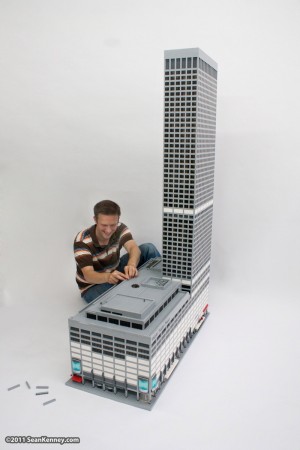A Million (And A Half) Little Pieces: New York Artist Sean Kenney Creates Unbelievable Sculptures with Tiny Bricks
Lego; you know, those little multicolored building blocks you had as a child. Chances are, you undoubtedly bragged to your friends about how many Lego toys you had. It was a sign of status, and countless hours of imagination running wild, in an era before video games, iPads, and the adult world took over. Maybe you had a few hundred Lego bricks; maybe a few thousand. Or maybe even tens of thousands. But then, you’ve probably never had as many as Sean Kenney: he has 1.5 million.
So what does he do with all those Lego pieces? Simple: the New York-based Kenney creates massive sculptures with a level of detail that borders on the absurd.
After working a desk job for 10 years, Kenney decided to work with Lego bricks full-time. Since then, he has created pieces for television, celebrities, tourist attractions, galleries, museums, and companies like Google, Mazda, Nintendo, JP Morgan Chase, and Samsung. He and his work have been featured in The New York Times, The Wall Street Journal, BBC news, ELLE, Good Morning America, and numerous documentaries and retrospectives about Lego, including a full-length documentary about Kenney.
Kenney is also the author of Cool Cars and Trucks, Cool Robots and Cool City, a series of building-guides for children. He also runs MOCpages.com, the world’s largest Lego fan community.
The self-proclaimed “professional kid” recently took some time out of his understandably hectic schedule to chat with GALO. Here’s what he had to say.
GALO: Why work with Lego?
Sean Kenney: Traditional sculptures in clay, bronze, and stone are very serious looking. But a sculpture made with Lego bricks is fun and bright and something everyone can relate to! When you look at a Lego sculpture, you understand how it was put together, and maybe even can imagine doing it yourself. It’s great to watch kids get excited and start creating things themselves. You don’t see that same thing happening when people view bronze sculptures or oil paintings. Plus, I get to play with toys and make people smile, what better job could there be?
GALO: What is designing a piece like?
SK: I like to build the “old fashioned” way, just by sitting down with my Lego pieces (and maybe a photograph or two of whatever I’m building), and just see where it takes me. Sometimes I’ll draw out my ideas on graph paper or build little prototypes before I begin.
When I’m designing a model, I gather as many photographs or drawings of the subject as I can, and then use graph paper to plan out the basic shape and size. After that, I start building a prototype, using my drawings for scale and the photos as a visual guide. There’s a lot of visualization required, and I often have to step back and examine the model from all sides as it is coming together, often taking sections apart and re-building them. Depending on the size of the sculpture, it can take anywhere from a few days to [several] weeks, or even months.
I don’t use computers to plan out my sculptures… it’s far too complex. And, if you ask me, it takes all the fun out of it!
GALO: Is there a favorite piece you’ve created? Why that piece?
SK: Perhaps my favorite model is a 50,000 piece city inspired by New York’s historic Greenwich Village. It was a true labor of love, assembled part-time over the course of six months in 2003. The model is intricately designed, capturing everything from street vendors and parking meters to historic buildings, high rises, taxicabs, and graffiti. Even the Lego people in the city mimic the hustle and bustle of the locals and tourists you’ll find on any New York City street corner. The model garnered a great deal of popularity and was broadcast on TV and news around the world. That year, it was exhibited at an international design gallery in Chelsea, in addition to an event honoring Freedom Tower architect Daniel Libeskind.
I’m also very partial to a small sculpture I made called Success. It’s a personal statement about how we look at success and what it means to be “successful.” In some ways, it is a portrait of me before I left my former career to pursue art full-time.
GALO: What inspires you?
SK: Seeing people enjoy my work inspires me to build even more cool things. For example, I was fortunate to help create an interactive Lego city for a big toy store (FAO Schwarz) in New York City. I visit the display often, and it makes me very happy to see kids truly excited about the work, smiling, jumping, pointing, and pushing buttons.
Instead of going to meetings, wearing a suit every day, and doing other boring things like most of my friends and family; I get to have fun all day and make people smile. What could be more inspiring?
(Article continued on next page)

